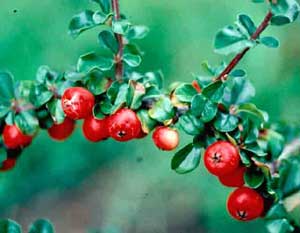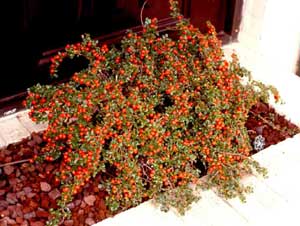Landscape Shrubs
Cranberry Cotoneaster
(Cotoneaster apiculatus)
Although the groundcover cotoneasters (Cotoneaster apiculatus, C. adpressus, C. horizontalis) may be better suited to central and northern Arkansas than to southern Arkansas, they are still a good group of deciduous shrubs. When grown under the right conditions, the spectacular fruit display, pleasing plant habit, and clean foliage make this closely allied group a wonderful addition to your landscape.
Let’s start with the fruit. In one way, cotoneasters are like hollies (Ilex). They can be separated into both black- and red-fruited species. Typically it is the red-fruited species that we cherish for landscaping. The brilliant red berry (technically a pome) fires up the landscape from August through September. Fruit size will vary from pea-sized to a small cranberry depending on the species and plant health. When fruit-set is heavy, these shrubs are a dramatic sight.
Unfortunately the flowers are not nearly so dramatic as the fruit. Small flowers (3/16”) that are white or soft pink appear in late May and last for about 10 days.
Leaves on all three species are dark, blue-green, and glossy, often with a wavy margin. In cooler climates, the foliage on these groundcover cotoneasters turns a vivid maroon fall color. You may need to move to Illinois or Ohio to really enjoy that impressive fall color.
The reason for lumping these three into one article is that they have only minor differences between them. The cranberry cotoneaster (C. apiculatus) is clearly very similar to the creeping cotoneaster (C. adpressus), and the two may be confused in the trade. The rock cotoneaster (C. horizontalis) can be distinguished from the previous two in that it has a very distinctive branching pattern that looks like fishbones or a herringbone pattern. Once you have seen this distinctive branching pattern, you will never confuse it with anything else.
Cotoneasters are like junipers in that they need to be situated in full sun. During establishment they will require constant moisture during our summer months, but once established they are fairly drought tolerant. Heavy, poorly drained soils would not be ideal. Amend heavy clay soils with organic matter to improve drainage.
The most common problem is bacterial fireblight. Cotoneaster is in the rose family (Rosaceae), so this comes as no surprise. To reduce the chances and severity of fireblight, improve air movement and certainly avoid overhead irrigation if possible. Watering this plant with drip irrigation is a good suggestion.
While any of these cotoneasters do well as a stand-alone plant, they also do well when massed. One danger in having a large mass planting, however, is that fireblight may spread like wildfire if it develops. Groundcover cotoneasters are ideal in rock gardens, train gardens, and cascading over walls. Some nurseries train this plant on a tall standard trunk. That form is very striking because you have the beautiful cascading branches extending down like foliage in a hanging basket. One more warning: because of the low, complex branching, this plant may become a magnet for blowing paper in commercial landscapes. Unlike quince (Chaenomeles), it is not dangerous to extract the debris from the tangled stems.
If you live in the northern third of Arkansas and you have a full sun situation, you should clearly give these groundcover cotoneasters a closer look. You may find an eye-catching addition to your landscape.
- Common Name: cranberry cotoneaster
- Varieties to look for: few
- Flower Color: faint pink
- Blooming period: late May
- Type: deciduous shrub
- Size: small; 1.5’ tall x 5’ wide
- Exposure: full sun
- Soil: well drained
- Watering: adaptable, but moist best
- When to prune: anytime
- Suggested use: ground cover
Leaves and fruit

Form with fruit
